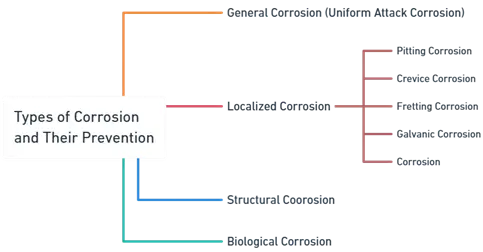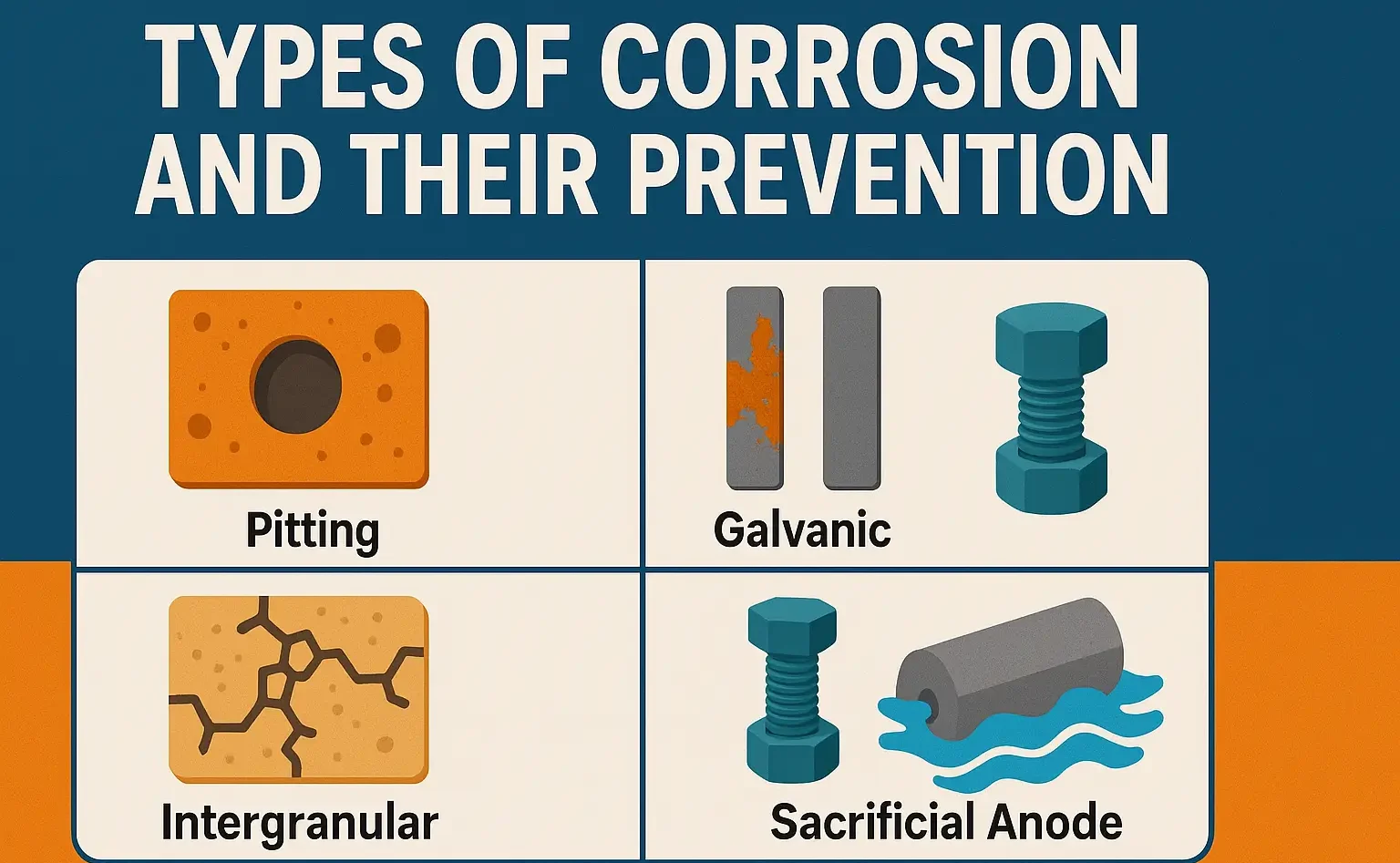Understand the different types of corrosion—like uniform, galvanic, pitting, and crevice—and learn effective prevention methods such as coatings, cathodic protection, andmaterial selection.“

General Corrosion (Uniform Attack Corrosion)
- Definition: Corrosion that occurs uniformly over a large surface area.
- Example: Rusting of iron in the atmosphere.
Prevention:
- Use of corrosion-resistant materials (e.g., stainless steel).
- Application of protective coatings (e.g., paint, galvanization).
- Regular maintenance and cleaning to remove corrosive agents.
- Use of corrosion inhibitors in the environment.
Advertisements
Localized Corrosion
Pitting Corrosion:
- Definition: Formation of small, localized holes or pits on the surface.
- Example: Pitting of stainless steel in chloride-rich environments.
-
Prevention:
- Use of materials resistant to pitting (e.g., high-alloy stainless steels).
- Application of protective coatings.
- Control of the environment (e.g., reducing chloride ion concentration).
Crevice Corrosion:
- Definition: Occurs in confined spaces where the access of the working fluid is limited.
- Example: Corrosion under gaskets, washers, or deposits.
-
Prevention:
- Proper design to eliminate crevices.
- Use of welds instead of rivets or bolts.
- Regular cleaning to remove deposits.
Fretting Corrosion:
- Definition: Caused by repeated cyclic rubbing between two surfaces.
- Example: Corrosion at contact points in machinery due to vibration.
-
Prevention:
- Lubrication to reduce friction.
- Use of anti-fretting coatings.
- Designing to minimize relative motion between surfaces.
Galvanic Corrosion:
- Definition: Occurs when two different metals are in electrical contact in a corrosive environment.
- Example: Corrosion of a steel pipe connected to a copper fitting.
-
Prevention:
- Use of metals with similar electrochemical potentials.
- Electrical insulation between dissimilar metals.
- Application of protective coatings.
- Use of sacrificial anodes.
Corrosion Fatigue:
- Definition: Accelerated cracking due to the combined effect of cyclic stress and a corrosive environment.
- Example: Cracking of metal components in aircraft due to repeated stress and exposure to the environment.
-
Prevention:
- Reducing cyclic stresses through design modifications.
- Use of corrosion-resistant materials.
- Application of protective coatings.
- Avoiding environments that promote corrosion.
Advertisements
Structural Corrosion
- Definition: Affects the structural integrity of materials, leading to weakening and potential failure.
- Example: Deterioration of steel beams in bridges, causing reduced load-bearing capacity.
-
Prevention:
- Use of corrosion-resistant materials.
- Application of protective coatings.
- Regular inspections and maintenance.
- Cathodic protection.
Biological Corrosion
- Definition: Caused by the activity of microorganisms, such as bacteria, algae, or fungi, which induce or accelerate corrosion processes.
- Example: Corrosion of metal surfaces in pipelines due to sulfate-reducing bacteria.
-
Prevention:
- Use of biocides to control microbial growth.
- Regular cleaning and maintenance to remove biofilms.
- Use of materials resistant to biological attack.
- Coatings that inhibit microbial attachment.
Click Here to Watch the Best Pharma Videos
Advertisements

